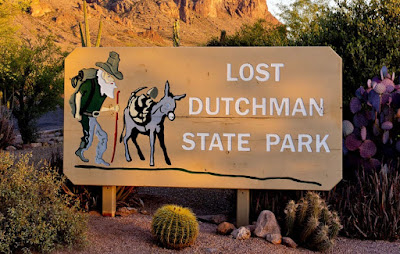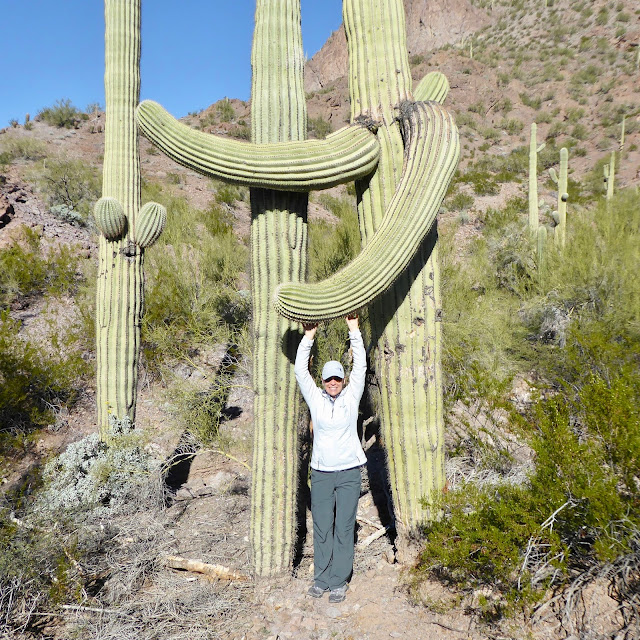Carol writes: As the calendar progressed toward the closing weeks of 2018, the Galus “mobile home bus” found itself doing a little “sort-of-dry-camping” at the scenic Lost Dutchman State Park in Apache Junction, Arizona.
The western ambience evoked by the location names and spectacular desert scenery helped create a relaxing week in our favorite setting for some much needed time down.
Lost Dutchman is an Arizona state park at the foot of the Superstition Mountains. The name has immortalized legends of the Old West that have recounted stories about hidden caches of gold.
The severely steep and dry canyons of the Superstition Mountains did not entice us to make any foolish attempts at finding so-called lost gold; however, the popular hiking trail through the foothills was to our liking, while meeting our level of safety, so we headed up for the view.

We decided that since our water rationing tactics were so successful at the Lost Dutchman, we would try another week of water-restriction camping at Catalina State Park, just north of Tucson. We were delighted with majestic evening sunsets,
framing a tableau of fantastic desert scenery throughout the park. This saguaro undoubtedly had the perfect microhabitat for such a profuse production of cactus arms.
Even typically waist-high barrel cactus reflected hyper growth spurts!
Catalina State Park was doubly rewarding in my mind, because in addition to superb hiking trails winding through the spectacular backdrop of the Santa Catalina Mountains, the park also had an archeological site of a Hohokam village at Romero Ruins dating back to 500 A.D.
I was plagued by a pesky head cold during our week at Catalina, and for a few days Al had vague sympathy symptoms along with mine. A few drizzly days that kept us inside (yes, winter is the rainy season in the desert), some good books, and some great football playoff games greatly assisted in our recovery back to health.
Sandwiched between each week at both Arizona state parks we hunkered down for two weeks on the outskirts of the tiny community of Florence, Arizona, midway between Tucson and Phoenix. We stayed at aptly named Desert Gardens RV Park,
a cooperative owned by a couple hundred residents. We rented our camping space from a resident who wasn’t using their lot this winter. The walking trail surrounding the park was just to the rear of our site. Even on days with chilly temperatures, the two-mile loop around the park was toasty warm in full sun.
Florence is “the other town named Florence” that has a sizable prison population, the other being the home of “Supermax” in Florence, Colorado. In Arizona’s Florence, the prison population of over 17,000 far exceeds the number of residents! Many prison guards have made Florence their home, and that is the reason why Florence boasts that it is one of the safest cities in the United States…
The week before Christmas, life was slow in Florence. We were disappointed to hear that nearby Casa Grande National Monument was closed due to the government shutdown.
So, we took amusement where we found it. In Florence, that was at the model airplane field.
We hunkered down at the Florence Desert Gardens RV co-op for our typical quiet holidays. Park management sponsored a full Christmas dinner, at which we enjoyed friendly conversation and great food with about 100 of the park’s residents.
The next day we welcomed our daughter, Megan, for a much anticipated visit. We spent a day at Biosphere 2, a research facility that started as an experimental closed system for developing self-sustaining space-colonization technology. This was just the sort of family fun we had been looking forward to.
In the early 1990s, four men and four women were sealed inside Biosphere for 2 years. Journal entries that were displayed revealed that during the experiment serious challenges surfaced related to the environment, duties, staffing, diet and food production, thus highlighting many obstacles that still must be solved before prolonged space exploration, such as a mission to Mars, can become a reality.
A tour of three habitats inside Biosphere 2—desert, ocean, and rainforest—along with a peek at the community kitchen
and individual living apartments
naturally conjured up thoughts of “could I do this?”
One of the most interesting experiments in Biosphere 2 was the one on aquaponics—a growing method that depends on fish, bacteria and recirculating water to grow plants at a faster rate but with significant water savings. I thought that using a koi pond to supply plant nutrients was a brilliant design… Whether this could be done on a large scale was an unanswered question for me.
Biosphere 2 is now a research facility operated by the University of Arizona.
The biosphere concept has furnished the ideal facility for studying ecosystem processes under closed conditions.
We capped off our visit with Megan with a shopping trip into Phoenix, followed the next day by… what else?… a mom-friendly family hike. The best hikes are the ones where I don’t take any tumbles,
… we get great family pics,
… there is time and energy for hijinks along the trail,
… and wonderful memories are created of family time together.
Carol Galus
Photo-Blogger

























No comments:
Post a Comment